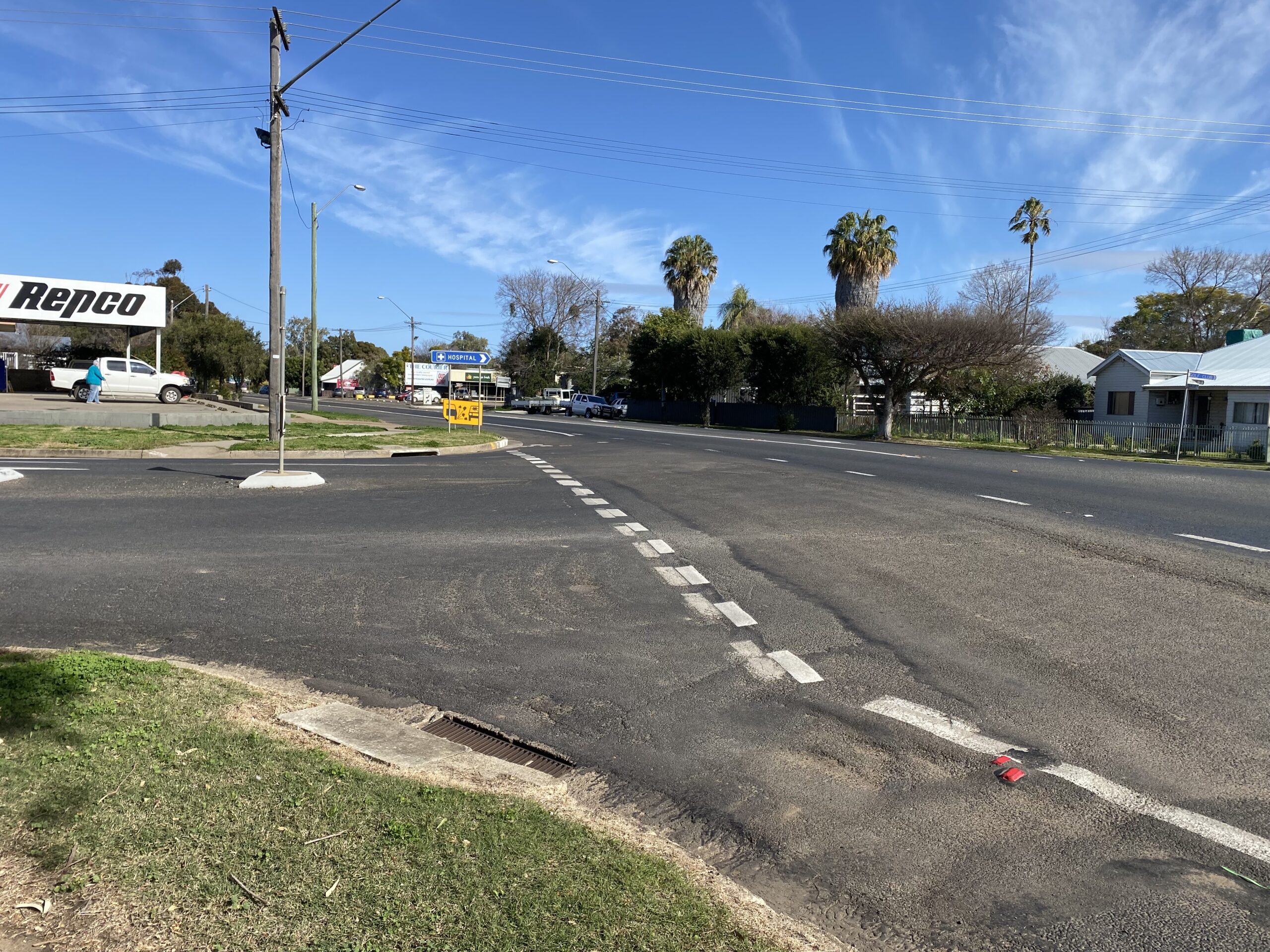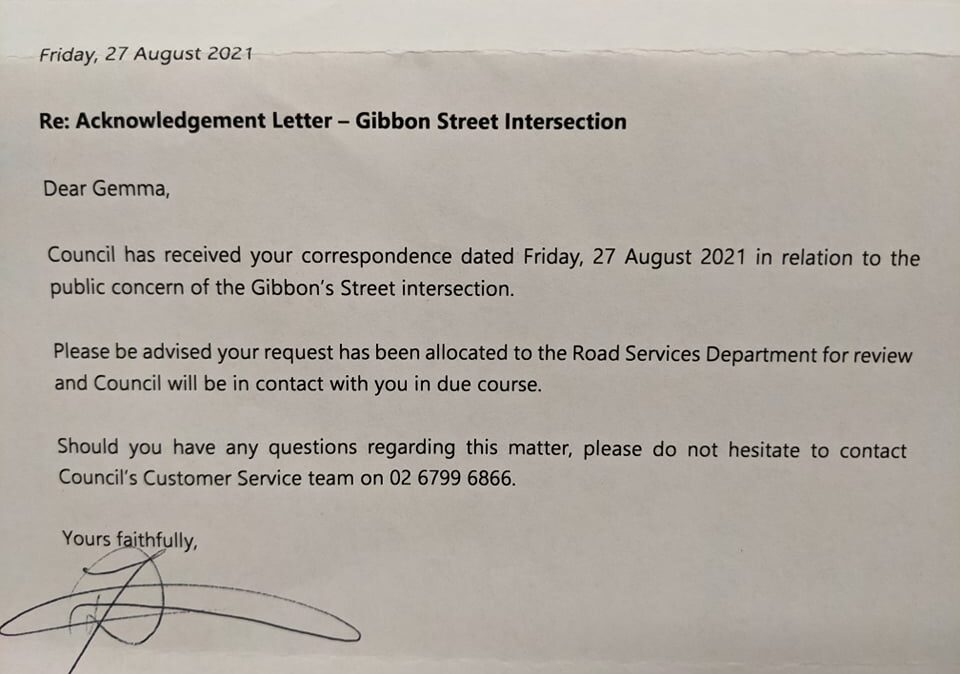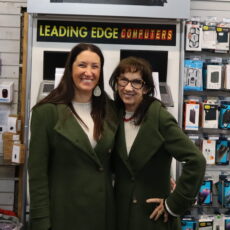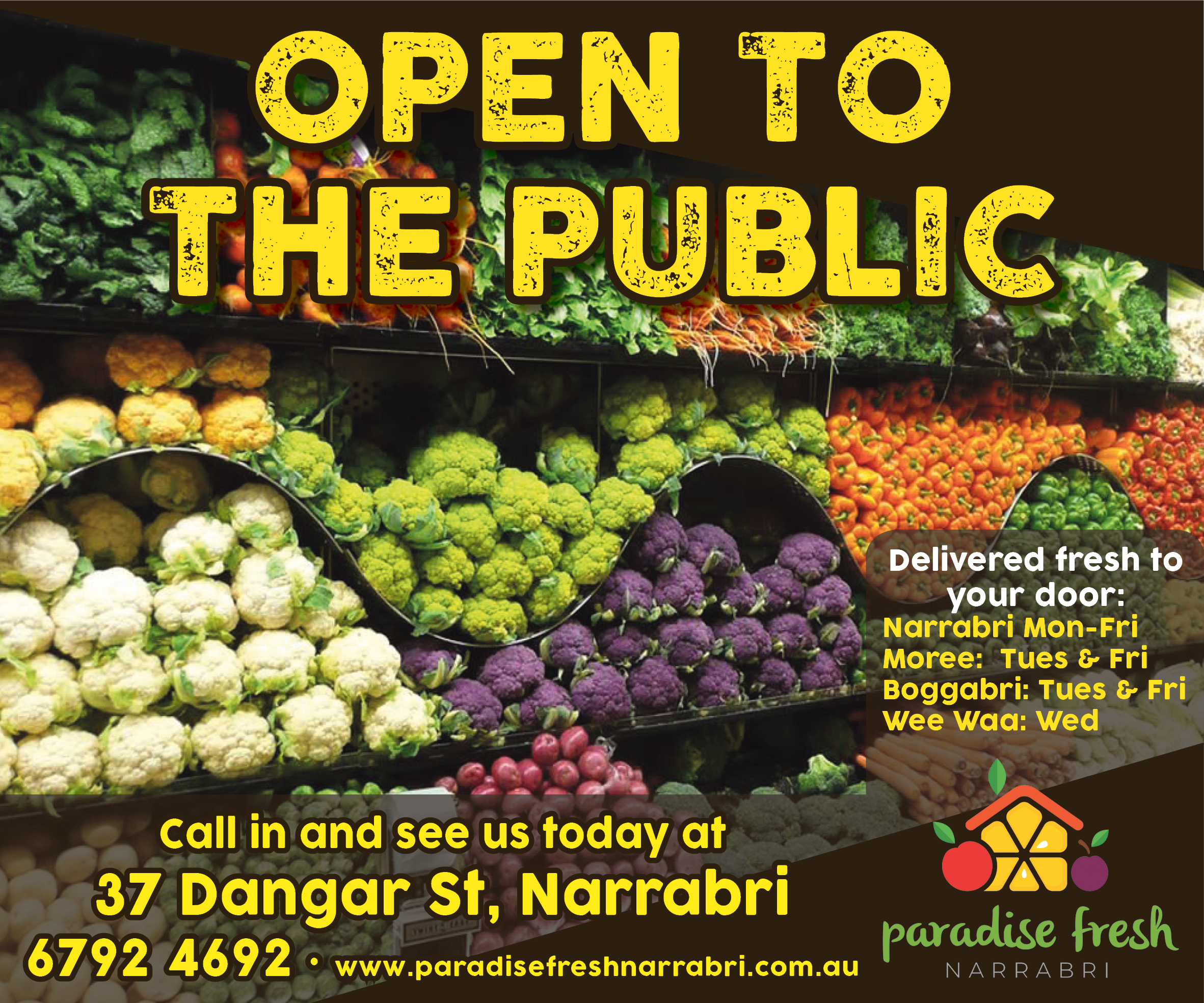In late July, an anonymous reader wrote to The Courier about the Gibbons Street intersection crossing over Narrabri’s main highway.
The subject was sent in as a ‘wish list item’ – that is, a suggestion for the shire’s new councillors to add to their agenda, ahead of local government elections.
The concerned reader claimed that the Gibbons Street-Newell Highway intersection is ready for a roundabout, noting that the turning corners are “becoming a worse chokepoint every day”.
They suggested a roundabout would “overcome traffic flow problems”, particularly for those wanting to cross two lanes of traffic in order to travel from one end of Gibbons Street to the other.
“It is a vital corner in Narrabri, leading down to the hospital and to the Gibbons Street entrance of the Whiddon Robert Young units, the Golf Club and of course all the residences along the street and in Brailoc Estate and Elizabeth Street,” the correspondent said.
“A roundabout at the site is the answer. I would like the new council to start lobbying to have one installed for smoother and safer traffic flow.”
The request was met with mixed public opinion, some encouraging the concerned reader, others suggesting alternative solutions, and a number of locals asking the intersection be left as is.
“The corner turning into the high school end of Gibbons Street needs serious resurfacing, you have to either take it wide or slow down dramatically,” one Facebook comment said.
“Roundabouts are a nightmare on high traffic roads,” a local on the opposite side of the debate explained.
“Traffic lights and roundabouts are not suitable for heavy transport operators to navigate,” an additional Facebook user commented.
“This intersection has been a major problem for years,” noted another.
Some readers said that a change to the road was long overdue, citing accidents and lives lost, while others claimed the intersection doesn’t see enough traffic to warrant any major changes.
The Courier’s cadet journalist, Gemma, saw the hot debate as the perfect topic for her latest assignment on public and constructive/solutions journalism.
She held a roundtable discussion this month, with local stakeholders, to explore public opinion and potential solutions to the great Gibbons Street debate.
In her research on the topic, Gemma found a 2013 article from The Courier that addressed the same issue.
At the time, the Narrabri branch of the National Party was seeking public support in preparing a case for the installation of traffic lights at the intersection.
As is the case in 2021, there were community concerns that the busy junction would be the scene of an accident as traffic volumes continue to grow.
Nationals member Jan McKenzie said the branch had been advised that the intersection was not suitable for a roundabout, but lights would be the traffic control method of choice.
The team were lobbying for an updated traffic count, since the last one done several years prior to 2013 found that the intersection’s traffic numbers were insufficient.
Ultimately, the road was not updated.
Gemma noted this in her findings before hosting the roundtable.
She also used the suggestions from readers and social media users to formulate specific questions for the panel members of the roundtable.
These participants included a member of the local police, an associate of the local member Roy Butler, a Gibbons Street resident, a representative of the Narrabri ambulance service, a Narrabri High School staff member, a local resident running in the upcoming local government election and a team member of the Narrabri Golfie.
Narrabri Shire Council and Transport for NSW were both asked to attend the roundtable but declined due to confusion over which body is responsible for the intersection, however both offered comments via email.
“The highway is a state road, but Gibbons Street is a local government responsibility, and funding certainly has an impact when assessing these kinds of issues,” the representative from Roy Butler’s office explained.
“If it was found that numerous accidents occur on the highway then that would be a state government responsibility, but if the call for change was coming from frustrated locals driving along Gibbons Street then it would be a matter for local Council.”
The main suggestions to fix the traffic congestion on the intersection include; turn the intersection into a painted or mountable roundabout, update the damaged road with Hot Mix Asphalt, change the Gibbons Street entries to left-turn only and introduce traffic lights.
The roundtable gathered insights from each of the participants and asked their opinions on the suggested solutions.
The police representative was asked about the safety of the intersection, including accidents along Gibbons Street, dangerous driving incidents such as hooning and the number of fatalities on the road.
“I have been unable to find any evidence of a fatal motor vehicle accident in the last 20 years,” he said.
“From what I can find, there have been only three major motor vehicle collisions at the location in the past two decades, the most recent being in February of 2021.”
“This would not indicate a large or even moderate risk factor at the intersection.”
The sergeant also suggested updates to the road would only disrupt those travelling along it.
“There is not enough traffic on Gibbons Street to warrant either option,” he said.
“Based on safety and cost, I don’t believe either option is warranted.”
Roy Butler’s office took a similar stance, explaining that they haven’t heard from many concerned locals on the intersection – “we’ve read about the subject in The Courier, but we haven’t heard any feedback personally that would suggest it’s a pressing issue”.
The representative echoed the police comments, explaining that traffic lights or a roundabout would not be suitable.
He suggested designated turning lanes instead to ensure increased driver safety and less road user stress.
The Gibbons Street resident was then asked about their experience with the intersection.
“I live down the golf club end of Gibbons Street, so I usually turn left at the intersection to go in to town,” she explained.
“However, on the occasions that I need to turn right, I usually take a detour using Kate or Collins Street, then Anne Street, before turning on to the highway there – it depends on the time of day.”
“It adds a little extra travel time, but it tends to be safer than trying to cross two lanes of traffic at the Gibbons Street entry points.”
The resident said she also uses the passage under the town’s main bridge, to go under highway traffic rather than over it, as many local drivers do.
“So I fear that making the Gibbons Street entrances left-turn only would add extra stress to these side street detours,” she said.
She cited a lack of patience as one of the main contributors to the issue.
“People want to get to their destination straight away and it often results in drivers misusing the road,” she said.
“I often have people cut me off in situations where they don’t even have right of way.”
“It’s this impatience and disregard for road rules that makes me feel uneasy about adding traffic lights or a new roundabout to the intersection – people don’t even use the roundabouts in the main street correctly, and I think these changes would result in more frustration while bottlenecking traffic.”
The ambulance officer offered similar feedback, noting that her team also use alternative routes like Kate Street.
She said, overall, the ambulance officers don’t often experience issues with the intersection.
“If we have a high priority job, we’re authorised to use lights and sirens, so we can get on to the highway responsibly and easily,” she said.
“That being said, there’s plenty of times – on those lower priority jobs – when we’ve had to sit in traffic and wait to either go straight or turn right on to the highway.”
“There’s been no adverse outcomes for patients as a result of us waiting in traffic on this road due to the triage priority system we use.”
The ambulance officer noted that oncoming traffic is one potential danger of the Gibbons Street-Newell Highway intersection.
“If our team are travelling from the station and need to overtake banked up traffic at the intersection, we will generally drive on the other side of the road,” she said.
“However, this results in the increased risk that someone could take the corner off the highway too quickly, not seeing our oncoming vehicle, which could cause an accident.”
The ambulance representative expressed concerns over traffic backup if lights or a roundabout were to be installed.
“This would be particularly worrying for heavy vehicles and wide loads, with them slowing down and then also making things slower for surrounding traffic,” she said.
“Not only will this cause more driver frustration, but I’m concerned a bank up of traffic will impact the safe crossing areas on the highway side of the nursing home – there’s a lot of elderly people, as well as school kids on bikes and such, using that refuge and I’m worried they’ll get trapped there.”
“Changing this intersection wouldn’t make much of a difference in terms of the ambulance’s access to the highway, since we have that option of lights and sirens if needed.”
In terms of the idea of left-turn only entries from Gibbons Street on to the highway, the ambulance officer predicted this would create access issues for the ambulance/hospital staff and patients.
“It would push us on to other streets in order to reach the highway to go right,” she said.
“And I can see this slowing down our response time in the long term.”
“Not only that, but traffic coming from the other end of Gibbons Street will be pushed on to Selina Street which already has similar issues and poor visibility.”
Narrabri High School was represented by a staff member who – like many students, teachers and parents – has the option of both Gibbons Street and Selina Street when travelling to and from the school.
He had similar comments regarding the neighbouring intersection at Selina Street.
“In the time I’ve been with the school, I haven’t heard any feedback or comments on usability issues with Gibbons Street,” he said.
“In my personal experience, I’d say Selina Street is the busier intersection since the bus stops are there and many parents use this for their pick-up/drop off.”
He echoed the ambulance officer, saying he’s been cut off by oncoming traffic due to poor visibility.
“So in my own opinion, Selina Street is more of a problem than Gibbons,” he said.
The resident running for Council agreed, suggesting the Selina Street intersection is more concerning than the Gibbons Street one.
“You kind of take your life in your own hands when you use Selina Street because there’s very little visibility, but I’m not sure Gibbons Street is such an issue” he said.
“I’m a member of a local community group that meets at the golf club and, while it’s usually a bit of a wait in traffic, it’s just a matter of patience.”
“It’s a major highway, so there’s bound to be lots of traffic, I think a roundabout would just bank those vehicles up – especially the trucks trying to travel around a roundabout.”
However, he did suggest that road upgrades should be a priority for local government.
“Having good roads and necessary updates is important for local Council – it’s a major issue to ensure driver and vehicle safety,” he said.
The aforementioned Selina Street alterative and its adjoining passageway under the bridge is also popular among staff at the Narrabri Golfie, as a team member of the establishment noted in his answers.
“When travelling to the Golfie, we usually take Tibbereena Street, over the main bridge and turn right into Gibbons Street,” he said.
“Or we travel down Selina Street, turn left onto the highway, then right into Gibbons Street.”
“We never travel along Gibbons from the southern end (from the high school direction) and try to cross at the highway, because of the volume of traffic moving in both directions along the highway.”
When asked how major changes to the intersection would impact the business, the Narrabri Golfie staff member said a roundabout would work best.
“There are a lot of golfers towing golf cart trailers to and from the club,” he said.
“In my opinion, a roundabout would provide a much better traffic flow on and off Gibbons Street.”
“If Gibbons Street becomes even more of a major access road for the heavy vehicles working on local projects, traffic congestion would increase significantly at the intersection creating more chaos.”
Responses from the roundtable’s individual answers mirrored that of local opinion, somewhat mixed and not all in favour of a roundabout or traffic lights at the intersection.
After each panel member answered their unique question, the floor was opened up to collaborative discussion with some group questions.
The stakeholders were asked if they had any further comments, outside of what had already been discussed, and what the best solution would be for the Gibbons Street intersection.
The representative for Roy Butler restated his suggestion for more defined turning lanes, with new markings on the Gibbons Street entries to the highway that clearly indicate different lanes for each direction of traffic.
“I think it would ease driver stress and help traffic merging on to the highway,” he said.
He also suggested this be backed up by a survey of traffic along the intersection, as well as the side street alternatives.
“Make sure the count is done at the right time – for example, not during school holidays – and use that evidence to build a case for road upgrades,” he said.
The ambulance officer also suggested upgrades to the surface of the road to correct any uneven spots, which was seconded by the Gibbons Street resident and the Narrabri High School staff member.
“When turning left off the highway to go towards the school, I’ve noticed that corner is very uneven and dangerous because it can cause you to lose control or concentration,” the school staff member said.
“Perhaps, in addition to retarring the road, some new signage would help – I feel there isn’t enough around, especially given how busy the intersection is.”
“For example, some residents park their cars on Gibbons Street near that corner off the highway, so there needs to be some system to make sure they aren’t being run into – new markings for turning lanes and more signage would clearly indicate where cars should drive and where they can park.”
The local running for Council agreed, saying turning lanes could be a feasible option.
“The current system is better than roundabouts or traffic lights, but I think designated turning lanes could work,” he said.
“However, it might impede on the curb or sidewalk in order to make way for the lanes.”
“Add more signs and make sure the road surface is as good as anywhere else along the highway.”
Ultimately, the decision was made to pen a letter to the Local Traffic Facilities Committee.
The body – which is made up of a representative from Council, the Police, Roads and Maritime Services and the local state member of Parliament – is required to advise the Narrabri Shire Council on traffic-related matters.
If Council supports the solution suggested by the roundtable, it can liaise with state government to take action.
The letter asks for an updated traffic count and targeted survey of local people who frequent the intersection.
It also suggests road upgrades, such as clearly marked turning lanes and new signage, following the traffic count and survey results.
Council replied to the correspondence, saying the request had been allocated to the Road Services Department for review.
See more like this:













